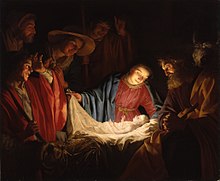

Chalking the door is a Christian Epiphanytide tradition used to bless one's home, which originated in medieval Europe.
Epiphany
Either on Twelfth Night (5 January), the twelfth day of Christmastide and eve of the feast of the Epiphany, or on Epiphany Day (6 January) itself, many Christians (including Anglicans, Episcopalians, Lutherans, Methodists, Presbyterians and Roman Catholics, among others) write on their doors or lintels with chalk in a pattern such as "20 ✝ C ✝ M ✝ B ✝ 24". The numbers in this example refer to the calendar year 2024 and the crosses to Christ. The letters C, M, and B stand for the traditional names of the biblical Magi (Caspar, Melchior and Balthazar), or alternatively for the Latin blessing Christus mansionem benedicat ('May Christ bless this house'), or IIIK referring to the three kings.
Chalking the door is done most commonly on Epiphany Day itself. However, it can be done on any day of the Epiphany season. In some localities, the chalk used to write the Epiphanytide pattern is blessed by a Christian priest or minister on Epiphany Day, then taken home to write the pattern.
The Christian custom of chalking the door has a biblical precedent as the Israelites in the Old Testament marked their doors in order to be saved from death; likewise, the Epiphanytide practice serves to protect Christian homes from evil spirits until the next Epiphany Day, at which time the custom is repeated. Families also perform this act to represent the hospitality of the Holy Family to the Magi (and all Gentiles); it thus serves as a house blessing to invite the presence of God in one's home.
In 20th century Poland, the practice of chalking the door continued among believers as a way of asserting their Christian identity, despite the Eastern Bloc's state atheism and anti-religious campaigns.
Gallery: Epiphany season door chalking
-
 Epiphany season door chalking on an apartment door in the Midwestern US
Epiphany season door chalking on an apartment door in the Midwestern US
-
Epiphany season door chalking at the Villa Reepschlägerbahn in Germany
-
 Epiphany door chalking at the Anglican Church of St Michael in Welling, London
Epiphany door chalking at the Anglican Church of St Michael in Welling, London
-
 Epiphany door chalking in Sexten, Italy
Epiphany door chalking in Sexten, Italy
-
Epiphany door chalking in Heidelberg, Germany
-
 Epiphany door chalking in Mittelberg, Austria
Epiphany door chalking in Mittelberg, Austria
Footnotes
- The blessing of homes, on whose lintels are inscribed the Cross of salvation, together with the indication of the year and the initials of the three wise men (C+M+B), which can also be interpreted to mean Christus mansionem benedicat, written in blessed chalk.
References
-
 One or more of the preceding sentences incorporates text from a publication now in the public domain: Chisholm, Hugh, ed. (1911). "Chalking the Door". Encyclopædia Britannica. Vol. 5 (11th ed.). Cambridge University Press. p. 807.
One or more of the preceding sentences incorporates text from a publication now in the public domain: Chisholm, Hugh, ed. (1911). "Chalking the Door". Encyclopædia Britannica. Vol. 5 (11th ed.). Cambridge University Press. p. 807.
- "A Catholic Dictionary". The Macmillan Company. 1958.
- Essick, Amber; Essick, John Inscore (2011). "Distinctive Traditions of Epiphany" (PDF). Center for Christian Ethics at Baylor University. Retrieved 6 February 2016.
- "An Epiphany Blessing of Homes and Chalking the Door". Discipleship Ministries. May 7, 2007.
- The Encyclopedia Americana. Grolier. 1988. p. 512. ISBN 9780717201198.
- Pennick, Nigel (21 May 2015). Pagan Magic of the Northern Tradition: Customs, Rites, and Ceremonies. Inner Traditions – Bear & Company.
- Mazar, Peter (2015). To Crown the Year: Decorating the Church through the Seasons (Second ed.). Liturgy Training Publications. p. 241. ISBN 9781616711894.
- "Directory on Popular Piety and the Liturgy". Principles and Guidelines. Vatican City: Congregation for Divine Worship and the Discipline of the Sacraments. December 2001. Retrieved 3 January 2020.
- Klimakin, Eugeniusz (6 January 2017). "Why do Poles write K+M+B on their doors?". Culture.pl. Retrieved 4 January 2022.
External links
- Epiphany Door Chalking by Christ the King Anglican Church
- An Epiphany Blessing of Homes and Chalking the Door by Discipleship Ministries of The United Methodist Church
- Chalking the Door: An Epiphany House Blessing 2016 Archived 2017-12-22 at the Wayback Machine by the Roman Catholic Order of Carmelites
| Epiphany | |
|---|---|
| Calendar |
|
| Topics | |
| Traditions | |
| Hymns and carols |
|
| Noted works | |
| Catholic prayers and sacramentals for protection against evil | ||
|---|---|---|
| Prayers | ||
| Sacramentals | ||
| Nativity of Jesus | ||||||||
|---|---|---|---|---|---|---|---|---|
| People |
|  | ||||||
| Place | ||||||||
| Gifts of the Magi | ||||||||
| Narratives |
| |||||||
| Related | ||||||||
| In culture | ||||||||
| Remembrances | ||||||||